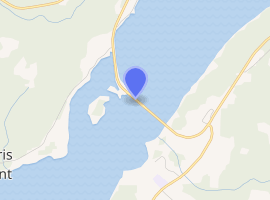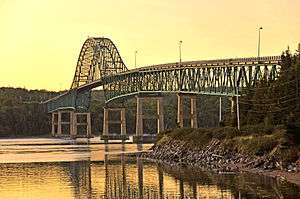Seal Island Bridge
The Seal Island Bridge is a bridge located in Victoria County, Nova Scotia. It is the third longest bridge span in the province.
Seal Island Bridge | |
|---|---|
The Seal Island Bridge as seen from Boularderie Island. | |
| Coordinates | 46°14′2.84″N 60°29′32.78″W |
| Carries | (Trans-Canada Highway 105) Motor vehicles |
| Crosses | Great Bras d'Or |
| Locale | Cape Breton Island (Victoria County, Nova Scotia – Boularderie Island) |
| Official name | Great Bras d'Or Crossing |
| Other name(s) | Seal Island Bridge |
| Maintained by | Department of Transportation and Infrastructure Renewal (Nova Scotia) |
| Characteristics | |
| Design | Through arch bridge, Truss arch bridge |
| Material | Steel |
| Trough construction | Steel and Reinforced concrete |
| Pier construction | Reinforced concrete, faced with stone at the waterline |
| Total length | 716.28 m (2,350 ft) |
| Width | 2 lanes |
| Longest span | 152.4 m (500 ft) |
| No. of spans | 8 |
| Piers in water | 7 |
| Clearance below | 36 m (118 ft) at centre-span |
| History | |
| Construction start | 1960 |
| Construction cost | $4,652,850[1] |
| Opened | 1961 |
| Rebuilt | 2001-2004 (Deck replacement) |
| Replaces | ferry service at Ross Ferry/Big Harbour and Big Bras d'Or/New Campbellton |
| Statistics | |
| Daily traffic | 7,500 vehicles/day, peak periods |
| Toll | none |

| |
It is a through arch design and crosses the Great Bras d'Or channel of Bras d'Or Lake, connecting Boularderie Centre, Boularderie Island on the south side with New Harris, Cape Breton Island on the north side.

Construction
Construction of the Seal Island Bridge began in 1960 as part of the Trans-Canada Highway project. The bridge, officially known as the Great Bras d'Or Crossing, was completed in 1961 at a cost of about $4,652,850. The construction of 23 kilometres (14 mi) of approach roads increased the total cost of the project to about $6-million. The bridge is a crucial link in the Trans Canada Highway between Sydney and Baddeck, carrying more than 7,500 vehicles a day in peak periods.[1][2] The structure carries 2 traffic lanes of Highway 105 and was originally constructed with a pedestrian sidewalk on each side.
The bridge crosses part of the channel on a causeway connecting the north shore of the channel to Seal Island, a small wooded island. The structure consists of eight steel box truss spans; three simply supported 76.2 m (250 ft) approach spans, two simply-supported 76.2 m (250 ft) splay spans, and a three-span continuous main span that consists of two 106.68 m (350 ft) side spans and a 152.4 m (500 ft) centre arch span.[3] The steel structure is supported on tall reinforced concrete piers, armoured with cut stone at the waterline.
Closures due to wind
Due to the bridge's height and location in a deep valley that can funnel winds, the Seal Island Bridge occasionally is closed to high-sided vehicles such as transport trucks. There have been a number of incidents on the bridge over the years with winds toppling transport trucks.[4] At times these closures can last for a number of hours, causing traffic to back up. RCMP will stop high-sided vehicles at the bridge and inform they cannot cross. At times as many as 15-20 transport trucks can be lined up, waiting for conditions to improve so they can make the crossing.[5]
Controversy
The location of the bridge had proven controversial. It replaced two ferry services crossing the Great Bras d'Or; one at the northeastern end between New Campbellton-Big Bras d'Or, and the other at the southwestern end at Big Harbour-Ross Ferry.
For political reasons, it was decided to place the bridge halfway between the two ferry services on account of an outcry by communities fearing the loss of their transportation links. Unfortunately to do this required an extensive modification to the Trans-Canada Highway route on the eastern slope of Kelly's Mountain (240 m (790 ft) high), resulting in a 180° "switchback".
A safer alternative to continue the highway further east on a gradual descent of Kelly's Mountain toward New Campbellton, crossing at the northern end of the Great Bras d'Or channel was rejected. Likewise, a route between Beinn Bhreagh and Kempt Head at the extreme southwestern end of the channel (much wider waterway but avoiding Kelly's Mountain altogether) was never considered. A number of serious accidents have occurred on Kelly's Mountain and at the switchback at the base of the grade over the years, as many as 6 or 7 accidents taking place in some years.[6][7][8][9]
_Bridge.jpg)
Deck replacement
By 2001 it was found the existing cast-in-place concrete bridge deck was in poor condition. Forty years of wear and tear from traffic, and exposure to wind and salt spray, necessitated a major overhaul of the Seal Island Bridge. The road deck needed complete replacement, and the steel truss work needed reinforcement. Engineers had thoroughly inspected the rest of the bridge structure and found it to be sound and safe.[10] A major deck replacement project was undertaken.
Over the next three years the original cast-in-place concrete bridge deck was removed and replaced using full-depth, precast, prestressed, half-deck width concrete panels. It was necessary to complete one lane at a time, starting with the south lane, leaving the other deck in place so the bridge could continue to be used for vehicular traffic. Construction was completed with minimal traffic disruptions and the bridge remained open to single lane traffic throughout construction, with the exception of three, six-hour overnight closures planned per week. This project added several decades to the useful life of the bridge.
The new high performance precast concrete deck system is much more durable than conventional systems since it is less permeable and crack-free under service load conditions. The deck system adopted is significantly lighter than a conventional cast-in-place concrete deck system. This has resulted in considerable savings in the amount of truss reinforcement required, while providing sufficient mass and stiffness for damping purposes.[3] At the same time the guard rails (traffic barriers) were replaced over the entire length of the bridge, with the new guard rails set inside the main bridge trusses to better protect them from vehicle impact. Unfortunately this made the new bridge deck too narrow to retain the sidewalks so they were not replaced. This modification did result in wider traffic lanes. The overall cost of the bridge deck reconstruction was $15 million.[2][10] There are now "No pedestrian traffic" signs on each end of the bridge.
Awards
On April 20, 2004 it was announced the Seal Island Bridge Reconstruction Project had won the Lieutenant Governor's Award for Engineering Excellence. The Department of Transportation and Public Works shared the honours with consultants CBCL Limited of Halifax for the major overhaul of the province's third largest bridge.[2][10]
References
- "Bridge Birthday Celebrated". Nova Scotia Department of Transportation and Infrastructure Renewal. Retrieved 6 May 2012.
- "Bridge Fix A Winner". Nova Scotia Department of Transportation and Infrastructure Renewal. Retrieved 6 May 2012.
- "Project of the Month: September 2002 - Seal Island Precast Concrete Bridge Deck Replacement, Cape Breton, NS". Canadian Precast Prestressed Concrete Institute. Retrieved 6 May 2012.
- Burke, David (27 November 2019). "Transport truck crashes on Cape Breton's Seal Island Bridge". CBC/Radio-Canada. CBC News. Retrieved 10 July 2020.
- "UPDATED: Seal Island Bridge reopen to high-sided vehicles following lengthy delay". Cape Breton Post. Sydney, NS: SaltWire Network. 4 April 2019. Retrieved 10 July 2020.
- Wentzell, Brittany (30 August 2019). "Province looking at ways to improve driver safety on Kellys Mountain". CBC/Radio-Canada. CBC News. Retrieved 10 July 2020.
The local detachment has seen about seven serious accidents in that area in 2019. There were around six serious accidents there in that area in 2018.
- MacDonald, Peggy (4 December 2015). "Kellys Mountain accident in Cape Breton sees tractor-trailer jackknifed". CBC/Radio-Canada. CBC News. Retrieved 10 July 2020.
Tractor-trailers jackknife with some regularity at the same place at the bottom of Kellys Mountain every year, in an area of hairpin turns approaching the Seal Island Bridge.
- "UPDATE: Tractor-trailer overturns at bottom of Kellys Mountain Thursday night". Cape Breton Post. Sydney, NS: SaltWire Network. 23 August 2019. Retrieved 10 July 2020.
- "One dead in Kelly's Mountain roll-over". Cape Breton Post. Sydney, NS: SaltWire Network. 24 August 2019. Retrieved 10 July 2020.
The incident was the second in less than 48 hours on the windy stretch of road between the top of Kelly’s Mountain and the Seal Island Bridge.
- "Seal Island Bridge Reconstruction Project". Nova Scotia Department of Transportation and Infrastructure Renewal. Retrieved 6 May 2012.
External links
- Structurae: Seal Island Bridge (1961)
- Highway Cameras - Seal Island Bridge
- Boularderie Island Historical Society - Photos of the Seal Island Bridge Under Construction, 1960
| Wikimedia Commons has media related to Seal Island Bridge. |